

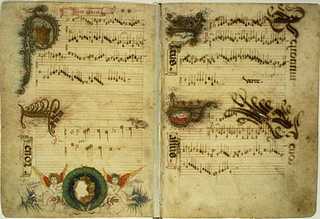
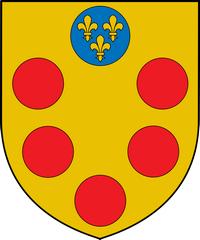
Born in Flanders circa 1450, Heinrich Isaac adds to the great significance of the Dutch (Netherlandish, Franco-Flemish) during the musical Renaissance, in his case, the high Renaissance. One reason for interest in Isaac is that before the fifteenth century music was composed mainly for voice, instruments left to a supportive role in secular music, allowed no place at all in sacred. Isaac wasn't the first to write textless music for instruments alone, but he illustrates the early emergence of the chamber ensemble in particular. Chamber music since Isaac generally consists of two to seven instruments. It was called "chamber" simply because it was played in small spaces for select audiences rather than staged for large audiences in a cathedral or on a palace lawn. In Isaac's time a chamber ensemble would have included such as the recorder, the viol, et al. Along with instrumentals Isaac composed songs (chansons) in multiple languages, as well as sacred motets and Masses.
Isaac may have been composing by 1470 (age 20) but his earliest known employment wasn't until 1484 as a singer for Duke Sigismund of Austria, House of Habsburg. This would come to distinguish Isaac from other Dutch composers of his period due to his influence in Germany via the Habsburgs. The significance of such is the greater upon noting that Martin Luther posted his '95 Theses' on the door of the Wittenberg Cathedral on 31 October 1517, not long after Isaac's death. That would, of course, affect the music of Europe, being the official date of the dawn of the Protestant Reformation encouraged from Italy by the Medici banking empire.
But the Protestant Reformation came too late to confront Isaac who in 1484 traveled to Italy where Roman Catholicism then had an intelligentsia in the shape of humanism with which to debate. Humanism fished from the pool that was ancient Greece. It helped put columns in architecture and would put "classical" in classical music for the next several hundred years as largely an interpretation of the Greek way of doing things. It was Lorenzo de' Medici, House of Medici, who had summoned Isaac to Florence in 1484. Isaac sang in Florence at the church of Santa Maria del Fiore, then the Santissima Annunziata from July 1485 to October 1486.
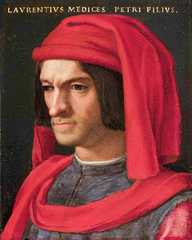
Lorenzo de' Medici (1449-1492)
Source:
Wikipedia
As with Isaac we are speaking not only of the golden years of the Renaissance but its hub in Florence, it is well to mention the Medici family which was its most generous source of funds apart from the Church, patronizing painters like Botticelli and literary figures such as humanist, Poliziano (Agnolo Ambrogini). The Medicis are traced to as early as 1230 and connected with medicine. But the dynasty commenced with banking, the Medici Bank established in Florence in 1397 in particular. The most familiar Medici coat of arms consists of five red balls or spheres ("palle" in Italian) on a field of gold with a sixth on top that is blue and bearing three fleurs-de-lis. It is speculated that such spheres may be pharmaceutically related (: pills) if not representative of Byzantine coins. Were the spheres gold rather than red they might have represented gold balls, which is how gold was minted in Isaac's time (rather than bars). The three lilies in the blue sphere indicate the sort of persuasion a Medici could exercise, as the fleur-de-lis was symbolic of French royalty. King Louis XI sanctioned its use on the Medici crest in 1465 to erase part of his debt. "Palle! Palle" might have been heard in the streets of Florence announcing some Medici occasion, and Isaac's 'Palle palle palle' was a fanfare to the Medicis. It would be sung at the coronation of the Medici Pope Leo X in 1513. Some of the wealthiest popes in history would be Medicis: Leo X from 1513 to 1521, Clement VII from 1523 to 1534, Pius IV from 1559 to 1565 and Leo XI in 1605. The Medici dynasty financed Europe as it would for another century until it finally went bankrupt in 1705. The Medici line continues to this date through the Princes of Ottajano. Isaac composed the lament, 'Quis dabit capiti meo aquam', upon the death of Lorenzo on 8 April 1492, that set to text by Angelo Poliziano. He sang, perhaps in a trio, at the coronation of Pope Alexander VI on 11 August 1492. Isaac remained with the Medici circle in Florence into 1496 during which time he married one Bartolomea Bello in 1495. 'Palle palle' below is rendered with period instruments. The shawm is an early clarinet which reed had developed in the 12th century. The sackbut is an early trombone which developed out of the slide trumpet which developed out of the military trumpet which brass instrument arrived in the latter 14th century. The slide trumpet was used in dance, having small utility in war. The double slide trumpet arrived in the latter 15th century. An angel plays one in its first documented depiction per 'The Assumption of the Virgin', a painting done in Rome by Filippino Lippi 1488-1493.
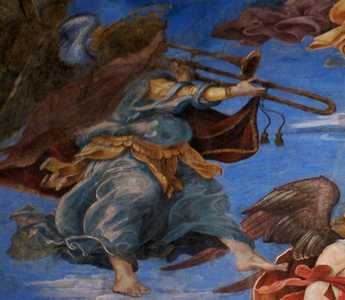
Detail of 'The Assumption of the Virgin' by Filippino Lippi 1488-93
First known image of an early double slide trombone
Source: Wikipedia
'Palle palle palle' Madrigal by Heinrich Isaac Fanfare to the House of Medici circa 1484 or so
"Palle" = "spheres" There are 6 palle on the most common Medici crest
MSS: Capella Giulia Chansonnier (Medici Chansonnier):
V-CVbav MS Capp. Giulia XIII.27 compiled 1492-94
For 4 voices arranged for period instruments:
Sackbut: Adam Bregman Shawm: Adam Gilbert / Malachai Bandy / Rotem Gilbert
Some are not entirely convinced that Isaac wrote the melody to 'Innsbruck, ich muss dich lassen' of 1485 but tradition ascribes it to him. The text to 'Innsbruck, I must leave' was written by one unknown. "MSS" herein translates to "manuscripts" which are transcription compilations, some illuminated, copied by scribes into books, chansonniers, codices, et al. (Its companion that is "RISM" refers to publications off a printing press, beginning for polyphonic scores with Ottaviano Petrucci's 'Odhecaton' in 1501). This page is stacked chronologically by composition date. If I can't identify that I go by the earliest date found in manuscript collections, or publications if that is case. Later manuscript or publication dates may or may not widely differ from earlier authorship. Titles herein are rendered as found in DIAMM.
'Innsbruck, ich muss dich lassen' For 4 voices Heinrich Isaac 1485
'Innsbruck, I must leave you'
MSS: Numerous posthumous from 1543
The Capilla Flamenca
It was probably 1487 when Isaac composed 'A la Battaglia' which was performed at the 1488 Florence Carnival. The theme of 'A la Battaglia' was Lorenzo's victory over the Genoese in taking the Fortress of Sarzanello during Serrezzana War between Genoa and Florence. Lorenzo is said to have participated in that battle, which would him a warrior in addition to a banker. Back in the day, such as counts (think county) and dukes (think state) weren't but landed aristocrats in happy financial situations gleaning off the top of what the vines produced in their realms. One also had to be what is called a "bad ass" willing to face a muddy enemy with wielded sword. A king or a pope might not themselves need to fight battles, go over the top (from the trench), so to speak. But everyone else was born to combat. Dukes didn't only direct their troops, but lead them in the charge. Renaissance aside, such were yet rough times even for the wealthy. As for the Fortress of Sarzanello, it soon ended up in the possession of Charles VIII of France who sold it back to the Genoese in 1494 upon its purchase by the Banco di San Giorgio. And so goes the history of Europe and history itself, its main story that of constant warfare. The DNA of any human being probably has a lot more tough built into it than any other animal. Other creatures graze or hunt in the elements, but they don't spend time a lot of time trying to kill each other. Imagine cows by now if they did that.
'A la Battaglia' ('To the Battle') Heinrich Isaac
Probably 1487 performed at the Florence Carnival 1488
MSS: Apel Codex D-LEu Ms. 1494 compiled in Leipzig c 1490-1504
The Concerto Palatino
Another title composed by Isaac during his association with the Medicis was 'Un di lieto gia mai', that a setting to lyrics by Lorenzo who was also a poet documented in Italian and English by Naxos. Texts in English at Elfinspell.
'Un di lieto gia mai non hebb'amor' Melody for STB by Heinrich Isaac by 1492
'I've not had a happy day again, love'
Lyrics: Lorenzo de' Medici
MSS: I-Fn MS Banco Rari 230 compiled in Florence 1492-94/c 1500/1513 >
L'Homme Arme directed by Fabio Lombardo
Among other titles written while with the Medici was Isaac's motet, 'Quis dabit capiti meo aquam', borrowing from his earlier 'Missa Salva nos Domine'. This melody was set to a lament written in Latin by Angelo Poliziano upon the death of Lorenzo on 8 April 1492, ill of undetermined cause at only age forty-three. One thing that plants Isaac in the midst of the glory days of the Renaissance is Petrucci's later inclusion of it in 'Motetti de passione de cruce' of 1503. What Gutenberg's printing press of circa 1440 in Mainz, Germany, did for literature in general Petrucci did for printing scores via movable type. Petrucci didn't invent movable type, Ulrich Han doing that to print chant for single voice in 1476 in 'Missale Romanum'. But Petrucci was the first to employ movable type with polyphonic scores per the 'Canti A' of his 'Harmonice Musices Odhecaton' (complete contents) of 1501. Han printed mostly literature, leaving Petrucci to specialize in music. No longer would scores be exclusive to those heretofore copied by hand, such as in books compiled for royalty, and now sheet music was on the horizon.
'Quis dabit capiti meo aquam?' Motet for ATTB Heinrich Isaac 1492
'Who will give water to my head?'
MSS: Capella Giulia Chansonnier (Medici Chansonnier):
V-CVbav MS Capp. Giulia XIII.27 compiled 1492-94
Published in Petrucci's 'Motetti de passione de cruce' of 1503
Corvina Consort directed by Zoltán Kalmanovits
Isaac's motet in two parts, 'Tota Pulchra Es', is assumed to have been authored prior to leaving the Medici circle, as it is found in several Florentine codices, three perhaps originally made for Giuliano de' Medici, though I'm thinking (assuming) that Isaac's motet was too late for inclusion in compilations of circa 1492-4 and didn't get added until much later circa 1515-18. 'Tota Pulchra Es' is a Catholic prayer written by one anonymous in the fourth century using passages from Solomon's 'Song of Songs' (c 971-931 B.C.). Isaac wrote two versions of Part I that is 'Tota pulchra es amica mea et macula'. Part II as rendered at DIAMM is 'Flores apparuerunt vineae florentes'.
'Tota Pulchra Es' Motet for SATB Heinrich Isaac c 1495
'You are altogether beautiful'
MSS: I-CTb MS 95 & 96 c 1492-94 / 1515-16 for Medici
MSS: F-Pnm NAF 1817 1515-16 for Medici
MSS: I-Fn MS II.I.232 c 1515-21 Florentine
Published in Henricus Glareanus' 'Dodecachordon' of 1547
Tallis Scholars
Isaac remained in Florence until November of 1496 when he and his wife arrived to his appointment as court composer for King of the Romans, Maximilian I, in Vienna, later to become Holy Roman Emperor in 1508. Holy Roman emperors were elected German kings appointed Roman emperors by popes. The first Holy Roman Emperor had been Charlemagne from 800-814 A.D.. French and Italian kings pursued alliance as emperors with papal powers until amidst Europe's complex weave it shifted to German kings with Otto I in 962. Upon Charlemagne's death in 814 his realm was divided into three by the Treaty of Verdun (10 August 843) amounting to the Kingdom of France, the Kingdom of Germany (East Francia) and West Francia. Otto I became King of East Francia (Germany) upon inheriting the Duchy of Saxony in 936. He was crowned Holy Roman Emperor in Rome in 962 by Pope John XII.
Maximilian I was further a Habsburg monarch. The first Habsburg to be elected to the throne of Germany was Rudolph I in 1273. He began building the Habsburg House upon acquisition of Austria, part of Bavaria, in 1282. A couple centuries later Maximilian I acquired the Netherlands by marriage to Mary the Good of Burgundy. Philip the Handsome of Burgundy was Maximilian's first son who would briefly become the King of Castile in 1506. Mary bore Maximilian two more children, Margaret and Franz, before her death at age 25 in 1482. Maximilian's attempt to marry Anne of Brittany in 1490 was foiled by Charles VIII of France, whence Max married Bianca Maria Sforza in 1493 until her death in 1510, bearing no progeny. Though Franz died as an infant, Margaret lived to govern Netherlands. Philip, however, was father to Charles V, grandson to Maximilian who was crowned Holy Roman Emperor in 1508, and successor to Maximilian as Holy Roman Emperor in 1519, thereat establishing the Habsburg House in Spain. The Habsburgs would become one of the most powerful houses in Europe, forming monarchies in the New World as well, into the 19th century. Not a lot was decided in Europe without a Habsburg in it with a pope, excepting the rivalry of France (though Catholic), England and Protestants as of 1517 (Luther's '97 Theses'). It was thus a rather different environment to which Isaac arrived in 1496, as the House of Medici was sympathetic to a protestant movement that was a pain in the neck to Maximilian. Isaac would remain in service to Maximilian for nigh another twenty years. During that time he also traveled variously about northern Europe and Italy. But unlike the many Dutch composers who made France their natural turf, though Isaac set music to many a French lyric he is distinguished by having never visited France, unless one count his birthplace, Flanders, France, and its high possibility during the first thirty-four years of his life during which next to nothing is known.
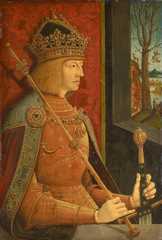
Maximilian I (1486-1519)
Holy Roman Emperor (1508-1519)
Source: Wikipedia
Another title finding print via Petrucci is Isaac's chanson, 'Et qui la dira', set to a Latin text by one anonymous. IMSLP has this in four parts SATB / STTB, though it is a textless instrumental as well. I remain clueless as to when this was composed. It finds its place in the stack on this page according to the 'Sicher Liederbuch' (MS 461) of the Stiftsbibliothek CH-SGS produced circa 1500 in the Low Countries (Netherlands) and presently housed in Switzerland.
'Et qui la dira'
Textless chanson
for 4 parts by Heinrich Isaac (text: anon)
'And who will say it'
MSS: Sicher
Liederbuch MS 461 compiled in the Low Countries c 1500
Published as
No. 11 in Petrucci's 'Canti A' of the 'Odhecaton' 1501
Recorder in 4
parts by Ricky Vilardell
Peter Philips of the Tallis Scholars has Isaac's six-part 'Missa de Apostolis' composed about 1500. Most Masses of the Ordinary include five parts, the Kyrie, Gloria, Credo, Sanctus and Agnus Dei. The Credo, however, is missing from Isaac's 'Missa de Apostolis' due to German custom at the time to not include it in the Mass. Isaac would, however, leave behind a number of polyphonic Credos perhaps otherwise sung in services (such as 'Missa O praeclara' in 1502 above). The 'Bayerische Staatsbibliothek' below was probably made in Vienna for Maximilian I.
'Missa de Apostolis' Mass for 6 voices by Heinrich Isaac c 1500
MSS: Bayerische Staatsbibliothek D-Mbs Mus. MS 31 compiled c 1510
Tallis Scholars
Having mentioned Maximilian's betrothal to Bianca Maria above, another of the most powerful families in Europe during the Renaissance was the House of Sforza which began by marriage into the Visconti family in 1441, making Francesco I Sforza Duke of Milan. The Sforzas were soon supplying lords to Pesaro and Gradara as well. Closer to Isaac's time, Ludovico Sforza was patron to Leonardo da Vinci. But the Sforzas, albeit dukes, were only dukes during tempestuous times, and died out in 1535 as the Renaissance continued without them. Nor were they patrons to Isaac. A dynasty more Maximilian's size that didn't employ Isaac either was the House of Este (Estensi). Documented as far back as the latter 10th century, it was Albert Azzo II, Margrave of Milan, who named himself after the castle he built at Este near Padua in the 11th century. Of Azzo II's three sons, his eldest, Welf IV, began what is called the Elder Este line who became dukes in Bavaria and Saxony, contributed one Holy Roman Emperor in Otto IV (1209-1218), then the dukes of Brunswick-Lüneburg in the 13th century. This line later fed into the Hanoverian monarchs of Great Britain in 1714 to 1901, of which the House of Hanover has continued since then to Prince Ernst August of Hanover born in 1954. The Welf lineage had also brought an Emperor of Russia in Ivan VI from 1740 to 1741.
Azzo II's second son, Hugh, inherited Maine, France, from his mother's dowry, sold it a year later and left no progeny. Azzo II's third son, Fulco I, commenced what is called the Younger Este. This lineage married into a wealthy family in Ferrara in the 12th century to became lords of the same where riots in 1385 inspired Niccolò II d'Este to begin building the Castello Estense. The Estes attained to yet greater heights as dukes of Modena and Reggio in the 15th century, to remain so for the next few centuries until 1796. Ferrara was rival to Florence during the Renaissance and the Estes major patrons to its flourish. This branch arrived to its demise in 1829. Another branch of Este the Younger, however, became the Habsburg-Este line by marriage in 1771 known as the House of Austria-Este. This line has produced dukes to the current Archduke of Austria-Este, Prince Ernst August of Hanover born 1955. The various Houses of Europe and their branches have both waned to the point you wouldn't know it or become some of the wealthiest people on the planet. All to introduce Isaac's motet, 'La mi la sol la sol la mi' written in 1502 for Ercole I d'Este in Ferrara.
The version of 'La mi la sol la sol la mi' below is thought to have been a textless Credo written for Ercole I d'Este's inspection in a bid for employment, based on its inclusion in the 'Basevi Codex' (I-Fc MS Basevi 2439) compiled in Brussels circa 1508. Isaac probably wrote this as an instrumental, as he is said to have spent only two days on it. The anonymous Marian text ('Rogamus te piissima virgo Maria') was added later for a four voice version, if not by Isaac, then perhaps Petrucci for publication in 1504 ('Motetti C'). The title specific to the instrumental is 'Missa La mi la sol' (solmization built into its structure) corresponding to 'Missa O praeclara' for voice. Isaac was competing with Josquin des Prez for the position that Ercole was opening, documented correspondence of which reveals that though Isaac's personality might have been more winning than Josquin's, the latter was thought the better composer overall. Despite that Josquin was asking 200 ducats a year compared to only 120 in Isaac's bid, Josquin received the job in Ferrara.
'Missa La mi la sol' (Corresponding to 'Missa O praeclara') 1502
Free form textless instrumental Credo by Heinrich Isaac
MSS: Österreichische Nationalbibliothek A-Wn Cod. 13713 Han compiled c 1500
MSS: I-Bc Q.18 compiled c 1502-06 in Bologna
MSS: Basevi Codex I-Fc MS Basevi 2439 compiled c 1506-14 (c 1508) in Brussels
MSS: GB-Lbl Add. MS 31922 compiled in London for Henry VIII c 1510-20
Cantica Symphonia directed by Guiseppe Maletto 2015
Arranged for recorder Aeolian Consort
'Missa O praeclara' for 4 voices (Corresponding to 'La mi la sol') 1502
Text by anonymous added by Isaac or Petrucci 1502-1504
MSS: Bischöfliche Zentralbibliothek D-Rp C 100 compiled 1560 (Preface)
'Rogamus te piisima virgo Maria' in Petrucci's 'Motetti C' of 1504
Cantica Symphonia directed by Guiseppe Maletto 2015
Ercole I d'Este apparently held a concert of works by Josquin and Isaac to estimate public reception between them, though just of what this "public" consisted is unidentified [Kate Wright at Katevents]. Wright has Isaac's 'Der Hund' performed at that event, an instrumental for three:
'Der Hund' Instrumental for 3 by Heinrich Isaac
Performed at the Court of Ercole I d'Este in Ferrara 1502
MSS: Heer Liederbuch CH-SGS MS 462 compiled in Paris 1510-30
Recorders: Tre Fontane: Julie Braná / Jakub Kydlíček / Marek Špelina
Come Isaac's six-voice 'Missa Virgo Prudentissima' once thought written in 1503, now placed later in 1507 about the time of his motet, 'Virgo Prudentissima'. He is thought to have composed the Mass in 1507 in Constance, present-day Germany, while Maximilian was there attending the Imperial Diet (of the Holy Roman Empire) in preparation for his crowning as Holy Roman Emperor in Trento in February of 1508. The Assumption of Virgin Mary in the text of Isaac's Mass is likely symbolic of Maximilian's rise to Holy Roman Emperor. The 'Virgo Prudentissima' motet in 2 parts is based on the same text. It is also employed in 'Gaudeamus omnes' found in 'Choralis Constantinus II' printed at least thirty years after Isaac's death. Between the Missa and the motet, which Isaac wrote first is undetermined. KBR below is the 'Koninklijke bibliotheek / Bibliothèque royale' compiled circa 1512 between 1508 and 1534 in Brussels, Belgium. The Biblioteca Apostolica Vaticana below refers to V-CVbav MS Capp. Sist. 24 copied in Rome for use at the Sistine Chapel long after Isaac's death.
'Agnes Dei' of 'Missa Virgo Prudentissima' Mass for 6 voices by Heinrich Isaac c 1507
MSS: Bayerische Staatsbibliothek D-Mbs Mus. MS 31 compiled c 1510
MSS: KBR B-Br MS 6428 compiled c 1512 in Brussels
Ensemble Gilles Binchois Sep 2015
Part 1 & 2 of 2 of 'Virgo Prudentissima' Motet for 6 voices by Heinrich Isaac c 1507
'Most Prudent Virgin'
MSS: Both parts in the Biblioteca Apostolica Vaticana compiled c 1538-50
Capella Sancti Michaelis
When Gregorian chants began to emerge about 900 A.D. they were intended for single voice because only monophony was thought to be sufficiently sober to convey sacred meaning. Motets were the first form of polyphony to arise in sacred music at Notre Dame back in the 12th century, those introduced by Léonin and further examined by his contemporary at Notre Dame, Pérotin. The sacred at Notre Dame had arrived in association with the University of Paris. Polyphony had also been employed by secular French troubadours (12th century) whose subject was more the passions of courtly love than the Passion of Jesus, something from which to keep sacred music disassociated until composers of the Burgundian School, slightly prior to Isaac, began combining Masses with secular melodies. Which is all to preface Isaac's 'Choralis Constantinus'.
Isaac was yet in service to Maximilian when he wrote the first set of 'Choralis Constantinus' commissioned for the Constance Cathedral (Konstanz Minster) in Germany in 1508. The entire 'Choralis Constantinus' is a collection of above 375 Gregorian chants written as motets completed by Isaac's Swiss student and copyist, Ludwig Senfl, the latter himself a composer of 240 motets, 7 Masses and 262 lieder (songs). Though Senfl died in 1543 Volume I of 'Choralis Constantinus' saw publishing in Nuremberg in 1550. Books II and III followed in 1555. 'Resurrexi' and 'Circumdederunt me' below are both are Introits, that is, sung as the priest enters and approaches the altar. Both also appear in 'Choralis Constantinus'. Isaac also wrote a six-voice 'Resurrexi' not included in 'Choralis Constantinus', though the only to be included in a manuscript collection prior to his death, that the 'Bayerische Staatsbibliothek' D-Mbs Mus. MS 31 made circa 1510 for use at the Court of Maximilian in Vienna.
'Resurrexi' Introit for 4 voices by Heinrich Isaac c 1508
MSS: numerous decades after Isaac's death
'Choralis Constantinus II' No. 6 1555
Ensemble Officium directed by Wilfried Rombach
'Circumdederunt me gemitus mortis' Introit for 4 voices by Heinrich Isaac c 1508-09
'The sorrows of death have assailed me'
Transcribed into manuscripts decades after Isaac's death
'Choralis Constantinus I' No. 33 1550
This chronological album at Discogs & Millennium of Music
'Lass Rauschen' is a textless instrumental for four written on an unknown date while with Maximilian but appearing in manuscripts only posthumously insofar as traced at DIAMM.
'Lass rauschen, lieb' Textless instrumental for 4 by Heinrich Isaac
'Let it rustle, dear' Date unknown: sometime while with Maximilian
MSS: posthumous:
Universitätsbibliothek D-Mu MS 8° 328-331 compiled 1524-26
Österreichische Nationalbibliothek A-Wn Mus.Hs. 18810 Mus compiled c 1524-33
Isaac died on 26 March 1517 while yet in the patronage of Maximilian who himself died not long after on 12 January 1519. Among the most prolific of Renaissance composers, Isaac left a legacy of several hundred compositions, mostly motets along with numerous Masses and profane (secular) works in French, German, Italian and Latin. Composer to the heydays of the Renaissance, he comes along just when the centuries-long tradition of composing for voice alone begins the tide of instrumental music at the roots of orchestras to come. He also arrives around the time that composing begins its gradual departure from formes fixes, imitatively mixing with other popular music or taking little free flights from designated form, springing a tiny leak toward what would eventually become the fantasy.
Additional Sources & References for Heinrich Isaac:
Habsburger (House of Habsburg)
History (House of Medici)
IMSLP (Rogamus te piisima virgo Maria - Anon)
Quire Cleveland (Rogamus te piisima virgo Maria - Anon)
Brian Robins
(AllMusic)
VF History (notes)
Voices of Music
(Leonardo
da Vinci)
Wikipedia
(English)
Wikipedia (German)
Wikipedia
(Holy Roman Empire)
Chamber Music:
Codices
(MSS = manuscript compilations):
Goldberg Stiftung
(Capella Giulia Chansonnier aka Medici Chansonnier aka
Medici Codex)
Compositions: Corpus:
American Institute of Musicology (Edward R. Lerner)
Choralis Constantinus (Formschneider 1550/55)
Misse Henrici Izak (Petrucci 1506)
Wikipedia (German)
Compositions: Individual:
A la Battaglia (1487)
Choralis Constantinus (Formschneider 1550/55)
Circumdederunt me (c 1508-09)
Innsbruck, Ich muss dich lassen (1485): Timothy Dickey Wikipedia
Missa Virgo Prudentissima (c 1507)
Palle palle palle (1484 or so)
Quis dabit capiti meo aquam? (1492):
Resurréxi (c 1508): Timothy Dickey Reinhard Strohm
Tota Pulchra Es (1495): Timothy Dickey Wikipedia
Un di lieto gia mai (< 1492): CPDL Timothy Dickey
Virgo Prudentissima (c 1507): Timothy Dickey Hyperion
High Renaissance Contemporaries of Isaac:
Jacob Obrecht: Music World Wikipedia
Ludwig Senfl (student)
Ercole I d'Este: Wikipedia (German)
Recordings of Isaac: Catalogs:
45 Worlds Discogs Hyperion Medieval
Recordings of Isaac: Select:
Ein frölich Wesen: Secular and Textless Music (Les Flamboyants directed by Michael Form)
Innsbruck, Ich muss dich lassen (Capilla Flamenca & Oltremontano directed by Dirk Snellings):
Johannes Heer Song Book: jpc musica Dei donum
Missa De Apostolis (Tallis Scholars directed by Peter Phillips)
Missa Virgo Prudentissima (Ensemble Gilles Binchois directed by Dominique Vellard)
Musica a Firenze: The Time of Lorenzo The Magnificent (L'Homme Arme directed by Fabio Lombardo)
Nell Tempo di Lorenzo de’ Medici and Maximilan I 1450-1519 (Hespèrion XXI & La Capella Reial de Catalunya directed by Jordi Savall):
All Music Discogs Millennium of Music
Scores / Sheet Music: Corpus: IMSLP Musicalics
Scores / Sheet Music: Individual:
A la Battaglia (1487)
Choralis Constantinus (Formschneider 1550/55)
Circumdederunt me (c 1508-09)
Innsbruck, Ich muss dich lassen (1485)
Quis dabit capiti meo aquam? (1492)
Tota Pulchra Es (1495)
Un di lieto gia mai (< 1492):
Virgo Prudentissima (c 1507)
Further Reading:
Dodecachordon (Henricus Glareanus / 1547)
Harmonice Musices Odhecaton (Petrucci / first polyphonic scores in movable type / 1501):
Canti A (Part I) IMSLP (Canti A-C) Wikipedia
Illuminated Manuscripts: Pinterest (Theresa Muir)
Heinrich Isaac:
David J. Burn (The Mass-Proper Cycles of Henricus Isaac / Merton College 2002)
Frank A. D'Acone (Music in Renaissance Florence / Ashgate 2006)
Home of Lorenzo il Magnifico (compositions various)
Alejandro Planchart (Notes on Heinrich Isaac's Virgo Prudentissima / Journal of Musicology 2011)
Blake Wilson (Heinrich Isaac among the Florentines / Dickinson College 2006)
The Medici Coat of Arms: DevianArt Doris Dong ThoughtCo
The Medici Family: Galileo Project (Rice University)
Lorenzo de Medici:
Naxos (poetry by Lorenzo)
William Roscoe (Lorenzo De Medici / Henry G. Bohn 1865)
The Medici Palace: Home of Lorenzo il Magnifico
Poliziano (poems various): Elfinspell
The Renaissance:
Music: W.W. Norton Young Composers
Spain: Smart History Wikipedia
Sarzana (Italy): Wikipedia
Sarzana Cathedral: Doinitaly
Sarzana Fortress: About Liguria Starforts
Bibliography:
Allan W. Atlas (A Note on Isaac's 'Quis dabit capiti meo aquam' / Journal of the American Musicological Society 1974)
Louise Elvira Cuyler (The Choralis Constantinus, Book III, of Heinrich Isaac / 1948)
Mark Delaere & Pieter Berge (Studies In Renaissance Music / Leuven U Press 2008)
William P. Mahrt (The Choralis Constantinus and the Organ / Brepolis 2011)
David J. Rothenberg (Virgo Prudentissima Compositions / Journal of Musicology 2011)
Authority Search: BnF VIAF World Cat
Classical Main Menu Modern Recording
|
|
hmrproject (at) aol (dot) com